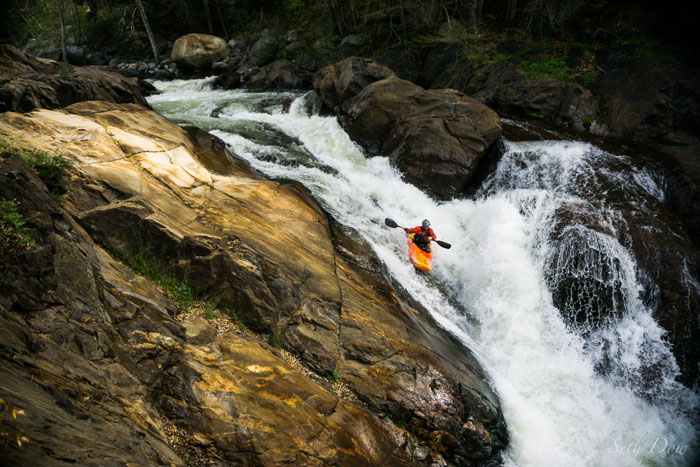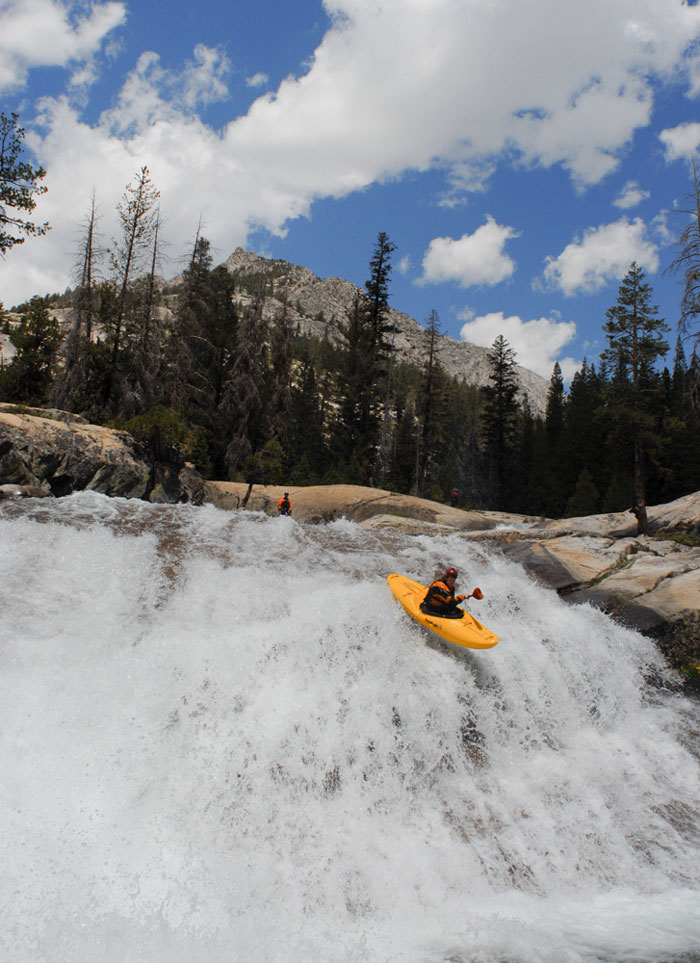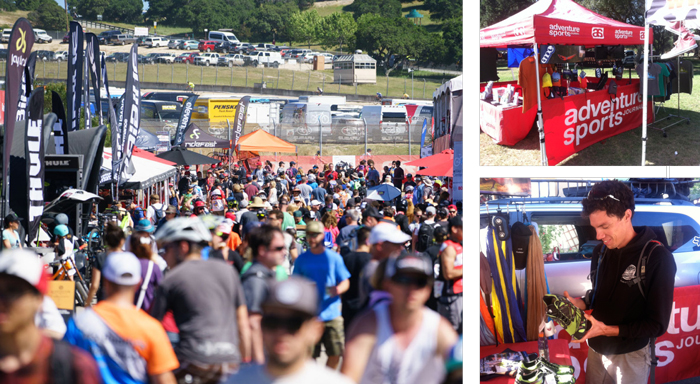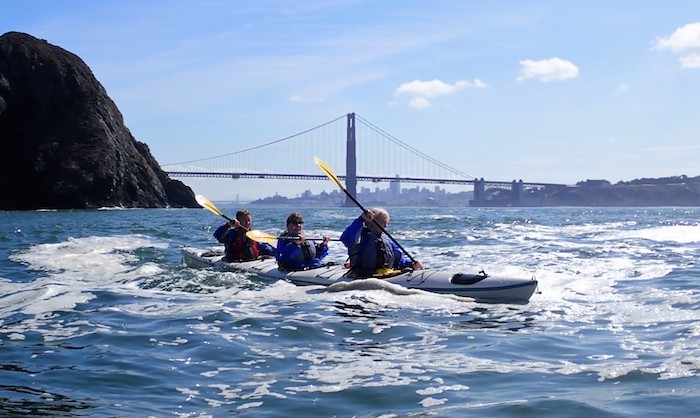- Paddling My Own Canoe - 10/01/2018
- West Coast Board Riders Club - 10/01/2018
- Never Too Oldfor Gold - 07/29/2018
Steeped in history, the Kings, Kaweah and Kern Rivers offer burly whitewater for serious kayakers
By Haven Livingston
As a healthy snowpack begins to pour from the mountains, southern Sierra rivers that have been largely forgotten over the past four years of drought are shining once again – a glorious sight in the eyes of California’s growing population of whitewater paddlers.
The Kings, Kaweah and Kern Rivers (from north to south) represent the three largest drainages in Southern California’s Tulare Basin and all originate in or near Sequoia-Kings Canyon National Park. The sister rivers each present unique personalities to kayakers that reveal themselves through their whitewater opportunities.
By fact of latitude, days on these rivers are warmer than their northern cousins. South facing slopes are increasingly adorned with agave as opposed to evergreens as you travel south. While paddlers on the Yuba and American River drainages are in drysuits, SoCal paddlers will be in shorts and searching for ice for their cocktail at the end of the day. Their patrons are a smaller and dedicated crew of locals punctuated by a few northern kayakers venturing south one or two weekends per year.
The Rivers K all have commercially rafted reaches that are easily accessible to Southern California, but for the private kayaker or rafter, they offer more challenging adventures to be explored during their spring and early summer seasons. All three rivers meet their end with a maze of dams and diversions, quenching agricultural fields and sprawling cities, but until they do, they are as wild and free as the boaters who ride them.
Kings River
While its name has nothing to do with kayaking, the Kings River watershed is home to royalty in the whitewater world and is decidedly the alpha of the three. In 1982, famed climber Royal Robbins made the first kayak descent of the Middle Kings River along with Doug Tompkins, Reg Lake and Neusom Holmes. This would be the final run of their first descents triple-crown mission – of which they had already hiked over the 13,777-foot Whitney Pass to descend the Kern River in 1981 and down Devil’s Postpile on the San Joaquin in 1980. The Middle Kings would be the largest and steepest of the three runs and today it has come to be known as the pinnacle of expedition kayaking in the US.
Dinkey Creek, a tributary that joins with the North Fork Kings, is arguably the best whitewater run in California and farther downstream, Garlic Falls is a classic California class V with outstanding scenery.
Class V aside, most people come for the lower Kings class III Banzai run. This run has the whole package. Free riverside camping and a forgiving layout (with the option to skip the biggest rapid at the put-in), make the long circuitous drive to get there well worth it. It is the perfect run for class II paddlers ready to make the move into class III. That said, it should still be taken seriously and professional kayak instruction is always the best move when upping your game as a kayaker.
Best bet for families: Bring mountain bikes and a Dutch oven for a full on camp-out weekend. Raft Banzai with a commercial company one or both days and pedal off into the foothills in the afternoon to enjoy the hills golden with poppies.
Kaweah River
Spilling through the town of Three Rivers, the Kaweah is the runt of the rivers and makes up for its small size with manic punches of steep terrain. The Middle Fork’s Boundary/Gateway Run is the only easy-moderate run and is the bread and butter of the Kaweah’s options. Beginning just inside the park entrance, this run starts off with a 15-foot vertical drop over an old dam and is non-stop class IV action for the next couple of miles. As the rapids begin to space apart, the calm pools drift past patios of restaurants in town where diners cheer on paddlers with beers and ice cream cones in hand, making you feel like you really are a rock star out there.
Upstream from Boundary is Hospital Rock, which, along with the East Fork, packs the highest flying class V punches with violent rapids and waterfalls of all the reaches. Though Hospital Rock is an experts-only run, anyone can walk to the first few rapids and watch the heavy hitters make the big drops.
One of the best wilderness adventure runs in the Kaweah watershed is the Upper North Fork. Type 2 fun begins with shouldering your boat and hiking four miles upstream past hillsides of sweet-scented wildflowers. For a class IV kayaker this run offers a scaled down introduction to the classic granite slides and waterfalls of the high Sierra in a low Sierra setting.
Best bet for intermediate-advanced kayakers: Run Boundary/Gateway the first day. First thing the next morning, hike into the Upper North Fork. Give yourself plenty of time to ogle the wildflowers on the way in (best in April) and bring a water filter; you’ll pass one stream along the hot hike. All of these runs on the Kaweah flow naturally so watch the gauges to catch the flow.
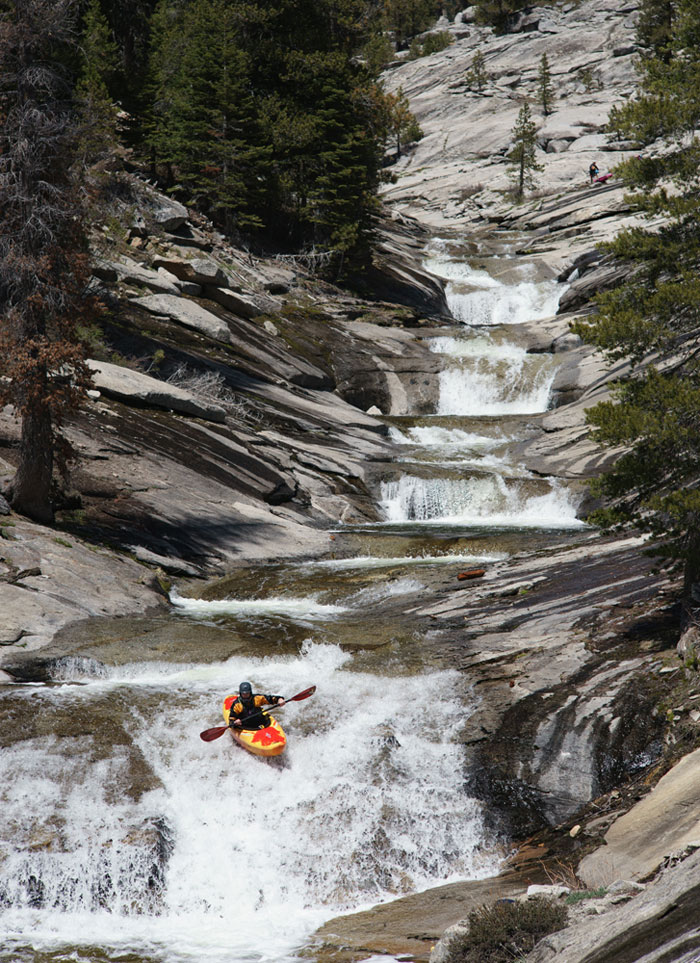
Jeff Wheeler enjoying perfect conditions on Clover Creek, tributary to the Kaweah River (Darin McQuoid).
Kern River
East of Bakersfield, the Kern River is the wise old friend with long tales to tell along its course. The Kern is the most infrequently run of these three rivers and though it used to support a burgeoning rafting community, the scene has dwindled in the drought years. After many years of the annual Kern River Festival being put on hold for drought, it was rejuvenated this April and the river saw its people return to celebrate its waters with friendly flows on easy stretches for all levels.
Some of the flows on the Kern are controlled by dam release and most are easily accessible road side. The tributaries boast some of the most scenic and exciting runs, like Dry Meadow Creek with its infamous “tea cup” waterfall drops and Brush Creek with its class III waterfall drop and slides. These rely on scant snow melt and are long gone by late spring, if they run at all.
The same goes for the classic off-the-beaten-path run, Forks of the Kern on the North Fork. The Forks run is a backcountry adventure that begins with a couple miles of hiking in, views of the granite Needles, and 14.5 miles of anywhere from class IV to V and portages depending on flows. The Kern is long and has a lot to offer; it’s just all about catching it at the right time.
Best bet for everyone: The Kern Festival is held in mid-April pending run-off, so as long as flows cooperate, it offers something for everyone. Events include extreme slalom and downriver races on Brush Creek, a triathlon, class II citizen slalom race for kayaks and SUP, sidewalk art contest and a build-your-own crazy craft parade.
If you miss the festival, there are still commercial rafting trips and private trips are better off starting earlier in the season.

Daniel Brasuell catches air between tea cups on Dry Meadow Creek, tributary to the Kern River (Darin McQuoid).

